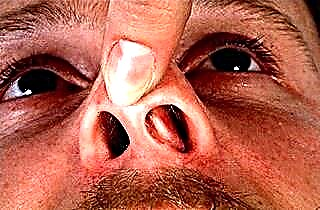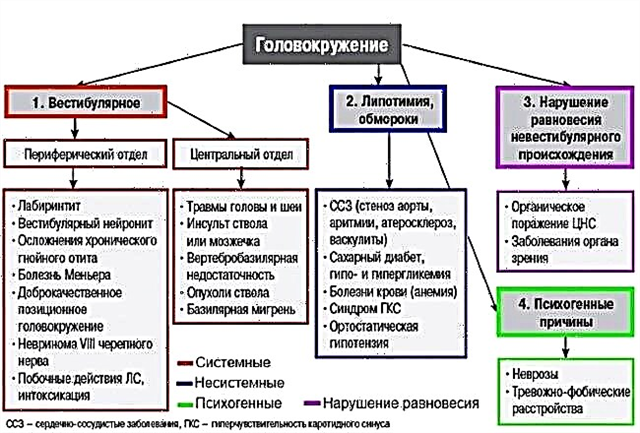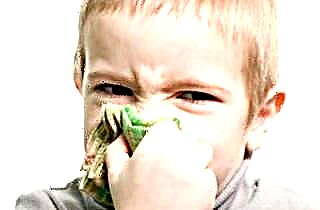Treatment of a cyst of the maxillary sinus is not always necessary. If it does not cause any concern and is not too large in size, then you can live with it all your life, without even knowing about its existence, until it accidentally "pops up". But such a peaceful neighborhood is not always the case. When a cyst becomes inflamed or burst, some rather unpleasant symptoms can appear. And then the question arises about the choice of methods of treatment or removal of this formation.
Causes and symptoms
 The main reason for the formation of a cyst is constant irritation of the nasal mucosa, as a result of which it gradually grows and thickens. A new layer of epithelium can block the duct through which the fluid produced by the mucous gland is removed to the outside. A cavity is gradually formed, filled with transparent mucus. If the problem persists, it continues to grow until it bursts, spewing out its contents.
The main reason for the formation of a cyst is constant irritation of the nasal mucosa, as a result of which it gradually grows and thickens. A new layer of epithelium can block the duct through which the fluid produced by the mucous gland is removed to the outside. A cavity is gradually formed, filled with transparent mucus. If the problem persists, it continues to grow until it bursts, spewing out its contents.
It would seem that it’s okay. Indeed, a small cyst of the maxillary sinus does not cause much concern. Therefore, it can only be detected by chance, for example, on an X-ray taken at the request of a dentist. It cannot be seen during normal visual inspection. But if the cyst becomes inflamed, pus forms in its cavity, it itself rapidly increases in size and can manifest itself with the following symptoms:
- persistent or frequent headaches;
- profuse discharge of mucus from the nose without other respiratory symptoms;
- swelling, redness, irritation of the nasal mucosa;
- feeling of pressure or fullness over the upper jaw;
- pain or discomfort when chewing;
- shortness of breath, nasal congestion (often on one side);
- mucous discharge with traces of pus or blood;
- pain with a sharp change in atmospheric pressure.
If you are constantly worried about one or more of the symptoms listed above, you need to see a doctor and get tested.
An inflamed cyst can cause many troubles: chronic ENT diseases, meningitis, otitis media, sepsis, decay of the bones of the upper jaw. Therefore, it is better not to wait for the development of complications, but to take action in time.
Prevention of cysts
When a cyst has already appeared in the maxillary sinus, treatment cannot eliminate it, but can only stop the growth. Therefore, like any other disease, it is easier to prevent it than to cure it. Cysts can be provoked by:
 severe allergic reactions if left untreated;
severe allergic reactions if left untreated;- physical and chemical irritants acting constantly;
- chronic respiratory diseases;
- frequent colds;
- smoking and other methods of intoxication;
- severe curvature of the nasal septum;
- uncontrolled use of vasoconstrictor drugs;
- too dry air in the work or sleeping room;
- constant trauma to the mucous membrane (with frequent picking in the nose);
- caries of the upper teeth or inflammation of the tissues of the jaw.
Preventive measures should be aimed at eliminating factors negatively affecting the condition of the nasal mucosa. This is primarily a healthy lifestyle and rejection of bad habits. It is also necessary to take measures to strengthen the immune system and improve the condition of the mucous membrane.
With acute respiratory infections, acute respiratory viral infections and other diseases accompanied by a runny nose, it is very important to complete the treatment in order to prevent chronic inflammation of the sinuses. Interestingly, sinusitis can cause cysts to form. And, conversely, due to decay and rupture of the cyst, sinusitis can begin. So everything in the body is interconnected and this must be taken into account.
It is necessary to visit the dentist at least once every six months. A false cyst in the maxillary sinus requires dental treatment in the first place, since it is the infection that penetrates through them that causes chronic inflammation of the nasal sinus mucosa. With frequent allergic reactions, antihistamines that stop them should be regularly used.
It is important to follow the rules of personal hygiene, regularly and thoroughly cleanse the nose from accumulations of mucus. It is necessary to monitor the cleanliness and humidity of the air in the room where you spend a lot of time.
And the main thing is to seek qualified help in time if strange and unusual symptoms are found. As long as a small cyst of the maxillary sinus, treatment can be conservative. If it grows too large, surgery will be required to remove it.
Treatment options
 There is no reliable way to treat a cyst conservatively. Even if it is somehow possible to reduce this formation, or it ruptures, when the underlying cause is not eliminated, after a while the cyst will grow back. Therefore, what to do in each specific case should be decided by the attending physician.
There is no reliable way to treat a cyst conservatively. Even if it is somehow possible to reduce this formation, or it ruptures, when the underlying cause is not eliminated, after a while the cyst will grow back. Therefore, what to do in each specific case should be decided by the attending physician.
Depending on the cause, location and condition of the cyst, the following options are possible:
- The cyst is small, does not grow, does not bother - active treatment is not required, but the patient is monitored. If education begins to increase, a decision is made on further actions.
- The cyst is provoked by dental problems. Treatment is aimed at solving them. A diseased tooth is filled or removed, periodontal disease or gum disease is treated conservatively. Usually, after this, the cyst decreases significantly or disappears completely.
- The cyst of the left maxillary sinus (or right) appeared against the background of chronic sinusitis. Treatment with antibacterial, anti-inflammatory and antihistamines is prescribed, which normalize the condition of the mucous membrane. Then the cyst is monitored. If it does not grow or become inflamed, you can leave it alone.
- Large, inflamed cyst in the maxillary sinuses. It will no longer be possible to cure it conservatively. There is only one way out - deletion. But even today this can be done without surgery, thanks to modern laser technologies.
Before choosing a treatment strategy, the doctor conducts a diagnostic examination. One x-ray is often not enough, since only the presence and approximate location of the cyst is visible on it. In order to obtain additional information, computed tomography, contrast imaging, and cyst tissue biopsy may be prescribed.
Traditional methods of treatment
Popular today folk methods of treatment in this situation are not only useless, but can seriously harm. For example, in no case should you use steam inhalation, especially with essential oils. They can cause increased mucus production and cause cysts to grow.
 You should also not drip and rinse your nose with herbal decoctions or tinctures (especially alcoholic ones). They can also activate the growth of cells, including those that make up the membrane of the cyst. For the same reasons, aloe is included in the list of prohibited drugs. Alcohol dries up mucous membranes, provoking even more secretion.
You should also not drip and rinse your nose with herbal decoctions or tinctures (especially alcoholic ones). They can also activate the growth of cells, including those that make up the membrane of the cyst. For the same reasons, aloe is included in the list of prohibited drugs. Alcohol dries up mucous membranes, provoking even more secretion.
Honey and propolis have good anti-inflammatory properties, but you can use them when you are completely sure that you will not be allergic to beekeeping products. That is, most of the traditionally used remedies for the common cold in this case will not be beneficial. What then remains?
There are several proven recipes for making nasal drops that can stop the growth of a cyst and even reduce its size (but not completely remove it!):
- Golden mustache is a long-known plant-healer, which, according to legend, even copes with oncology. Bury freshly squeezed juice 2-3 times a day for a month (3-4 drops).
- Shilajit is a natural biological stimulant, a mountain resin that has antiseptic, anti-inflammatory, antibacterial properties. Dissolve it in water, mix with glycerin and drip 5-6 drops several times a day.
- Juice from cyclamen tubers - has unique healing properties, but it cannot be used in its pure form. Part of the juice is diluted in 4 parts of water and instilled in the nose 3-4 times a day.
Important! You can use these drugs only if you are completely sure of their origin. When buying from the hands, you can buy completely different substances that will have the opposite effect: they will lead to inflammation and complications, and the maxillary sinus cyst will continue to grow.
Endoscopic removal
 If it became clear that conservative or alternative treatment does not lead to the desired results, it is better to solve the problem once and for all.
If it became clear that conservative or alternative treatment does not lead to the desired results, it is better to solve the problem once and for all.
Endoscopic removal is a quick and almost painless method of removing the cyst from the sinuses. The whole procedure takes 15-20 minutes, is performed on an outpatient basis and is not even considered an operation.
After a preliminary examination, which clarifies the condition of the cyst and identifies possible contraindications, the date of the operation is prescribed. Before it, a little preparation is carried out - they stop all inflammatory processes, and also exclude the intake of blood-thinning drugs: aspirin, etc. It is mandatory to study blood for biochemistry, coagulation and general analysis.
On the day of the procedure, the patient should not eat or drink. The manipulations are carried out under local anesthesia. Through the nasal passage, the endoscope reaches the wall of the maxillary sinus and enters it through a small opening. The cyst is carefully cut and pulled out. The procedure is absolutely bloodless, as it is carried out using a laser that seals the wounds. In the first hours, an ichor stands out from the nose. Sterile gauze tampons are inserted into it, and after a couple of hours the patient is sent home.
Control examination is carried out 3-4 days after removal of the cyst. Be sure to do a second X-ray. The first time you have to take care and take precautions:
- do not touch your nose unnecessarily with your hands;
- try to keep water out of it;
- do not visit the pool, sauna, solarium;
 do not stay in the open sun for more than 15 minutes (especially in summer);
do not stay in the open sun for more than 15 minutes (especially in summer);- avoid active physical activity;
- not to engage in contact sports;
- do not play ball and other traumatic games.
It is also necessary to strictly follow all the prescriptions of the doctor for the care of the nasal cavity and take the medications that have been prescribed. In 99% of cases, non-surgical removal of the cyst takes place without complications and solves the problem once and for all, so you should not be afraid of this simple manipulation.
It makes sense to solve the problem in other ways only when endoscopic removal is categorically contraindicated: during pregnancy and lactation, with exacerbation of chronic diseases, for patients with oncological, autoimmune, mental and serious cardiovascular diseases. But even in this case, it is necessary to be treated not independently, but under the supervision of a doctor.

 severe allergic reactions if left untreated;
severe allergic reactions if left untreated; do not stay in the open sun for more than 15 minutes (especially in summer);
do not stay in the open sun for more than 15 minutes (especially in summer);

